Fangzhen Lin
Multi-Task Vehicle Routing Solver via Mixture of Specialized Experts under State-Decomposable MDP
Oct 24, 2025Abstract:Existing neural methods for multi-task vehicle routing problems (VRPs) typically learn unified solvers to handle multiple constraints simultaneously. However, they often underutilize the compositional structure of VRP variants, each derivable from a common set of basis VRP variants. This critical oversight causes unified solvers to miss out the potential benefits of basis solvers, each specialized for a basis VRP variant. To overcome this limitation, we propose a framework that enables unified solvers to perceive the shared-component nature across VRP variants by proactively reusing basis solvers, while mitigating the exponential growth of trained neural solvers. Specifically, we introduce a State-Decomposable MDP (SDMDP) that reformulates VRPs by expressing the state space as the Cartesian product of basis state spaces associated with basis VRP variants. More crucially, this formulation inherently yields the optimal basis policy for each basis VRP variant. Furthermore, a Latent Space-based SDMDP extension is developed by incorporating both the optimal basis policies and a learnable mixture function to enable the policy reuse in the latent space. Under mild assumptions, this extension provably recovers the optimal unified policy of SDMDP through the mixture function that computes the state embedding as a mapping from the basis state embeddings generated by optimal basis policies. For practical implementation, we introduce the Mixture-of-Specialized-Experts Solver (MoSES), which realizes basis policies through specialized Low-Rank Adaptation (LoRA) experts, and implements the mixture function via an adaptive gating mechanism. Extensive experiments conducted across VRP variants showcase the superiority of MoSES over prior methods.
Emergent Hierarchical Reasoning in LLMs through Reinforcement Learning
Sep 03, 2025Abstract:Reinforcement Learning (RL) has proven highly effective at enhancing the complex reasoning abilities of Large Language Models (LLMs), yet underlying mechanisms driving this success remain largely opaque. Our analysis reveals that puzzling phenomena like ``aha moments", ``length-scaling'' and entropy dynamics are not disparate occurrences but hallmarks of an emergent reasoning hierarchy, akin to the separation of high-level strategic planning from low-level procedural execution in human cognition. We uncover a compelling two-phase dynamic: initially, a model is constrained by procedural correctness and must improve its low-level skills. The learning bottleneck then decisively shifts, with performance gains being driven by the exploration and mastery of high-level strategic planning. This insight exposes a core inefficiency in prevailing RL algorithms like GRPO, which apply optimization pressure agnostically and dilute the learning signal across all tokens. To address this, we propose HIerarchy-Aware Credit Assignment (HICRA), an algorithm that concentrates optimization efforts on high-impact planning tokens. HICRA significantly outperforms strong baselines, demonstrating that focusing on this strategic bottleneck is key to unlocking advanced reasoning. Furthermore, we validate semantic entropy as a superior compass for measuring strategic exploration over misleading metrics such as token-level entropy.
Beyond Distillation: Pushing the Limits of Medical LLM Reasoning with Minimalist Rule-Based RL
May 23, 2025Abstract:Improving performance on complex tasks and enabling interpretable decision making in large language models (LLMs), especially for clinical applications, requires effective reasoning. Yet this remains challenging without supervised fine-tuning (SFT) on costly chain-of-thought (CoT) data distilled from closed-source models (e.g., GPT-4o). In this work, we present AlphaMed, the first medical LLM to show that reasoning capability can emerge purely through reinforcement learning (RL), using minimalist rule-based rewards on public multiple-choice QA datasets, without relying on SFT or distilled CoT data. AlphaMed achieves state-of-the-art results on six medical QA benchmarks, outperforming models trained with conventional SFT+RL pipelines. On challenging benchmarks (e.g., MedXpert), AlphaMed even surpasses larger or closed-source models such as DeepSeek-V3-671B and Claude-3.5-Sonnet. To understand the factors behind this success, we conduct a comprehensive data-centric analysis guided by three questions: (i) Can minimalist rule-based RL incentivize reasoning without distilled CoT supervision? (ii) How do dataset quantity and diversity impact reasoning? (iii) How does question difficulty shape the emergence and generalization of reasoning? Our findings show that dataset informativeness is a key driver of reasoning performance, and that minimalist RL on informative, multiple-choice QA data is effective at inducing reasoning without CoT supervision. We also observe divergent trends across benchmarks, underscoring limitations in current evaluation and the need for more challenging, reasoning-oriented medical QA benchmarks.
Pixel Reasoner: Incentivizing Pixel-Space Reasoning with Curiosity-Driven Reinforcement Learning
May 21, 2025Abstract:Chain-of-thought reasoning has significantly improved the performance of Large Language Models (LLMs) across various domains. However, this reasoning process has been confined exclusively to textual space, limiting its effectiveness in visually intensive tasks. To address this limitation, we introduce the concept of reasoning in the pixel-space. Within this novel framework, Vision-Language Models (VLMs) are equipped with a suite of visual reasoning operations, such as zoom-in and select-frame. These operations enable VLMs to directly inspect, interrogate, and infer from visual evidences, thereby enhancing reasoning fidelity for visual tasks. Cultivating such pixel-space reasoning capabilities in VLMs presents notable challenges, including the model's initially imbalanced competence and its reluctance to adopt the newly introduced pixel-space operations. We address these challenges through a two-phase training approach. The first phase employs instruction tuning on synthesized reasoning traces to familiarize the model with the novel visual operations. Following this, a reinforcement learning (RL) phase leverages a curiosity-driven reward scheme to balance exploration between pixel-space reasoning and textual reasoning. With these visual operations, VLMs can interact with complex visual inputs, such as information-rich images or videos to proactively gather necessary information. We demonstrate that this approach significantly improves VLM performance across diverse visual reasoning benchmarks. Our 7B model, \model, achieves 84\% on V* bench, 74\% on TallyQA-Complex, and 84\% on InfographicsVQA, marking the highest accuracy achieved by any open-source model to date. These results highlight the importance of pixel-space reasoning and the effectiveness of our framework.
VL-Rethinker: Incentivizing Self-Reflection of Vision-Language Models with Reinforcement Learning
Apr 10, 2025Abstract:Recently, slow-thinking systems like GPT-o1 and DeepSeek-R1 have demonstrated great potential in solving challenging problems through explicit reflection. They significantly outperform the best fast-thinking models, such as GPT-4o, on various math and science benchmarks. However, their multimodal reasoning capabilities remain on par with fast-thinking models. For instance, GPT-o1's performance on benchmarks like MathVista, MathVerse, and MathVision is similar to fast-thinking models. In this paper, we aim to enhance the slow-thinking capabilities of vision-language models using reinforcement learning (without relying on distillation) to advance the state of the art. First, we adapt the GRPO algorithm with a novel technique called Selective Sample Replay (SSR) to address the vanishing advantages problem. While this approach yields strong performance, the resulting RL-trained models exhibit limited self-reflection or self-verification. To further encourage slow-thinking, we introduce Forced Rethinking, which appends a textual rethinking trigger to the end of initial rollouts in RL training, explicitly enforcing a self-reflection reasoning step. By combining these two techniques, our model, VL-Rethinker, advances state-of-the-art scores on MathVista, MathVerse, and MathVision to achieve 80.3%, 61.8%, and 43.9% respectively. VL-Rethinker also achieves open-source SoTA on multi-disciplinary benchmarks such as MMMU-Pro, EMMA, and MEGA-Bench, narrowing the gap with GPT-o1.
SplitQuantV2: Enhancing Low-Bit Quantization of LLMs Without GPUs
Mar 07, 2025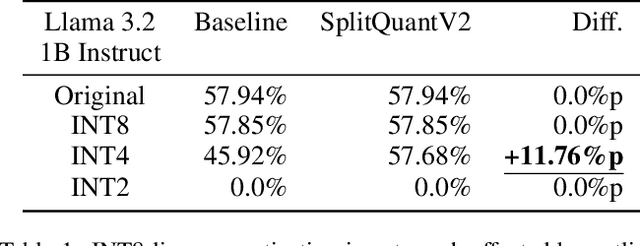

Abstract:The quantization of large language models (LLMs) is crucial for deploying them on devices with limited computational resources. While advanced quantization algorithms offer improved performance compared to the basic linear quantization, they typically require high-end graphics processing units (GPUs), are often restricted to specific deep neural network (DNN) frameworks, and require calibration datasets. This limitation poses challenges for using such algorithms on various neural processing units (NPUs) and edge AI devices, which have diverse model formats and frameworks. In this paper, we show SplitQuantV2, an innovative algorithm designed to enhance low-bit linear quantization of LLMs, can achieve results comparable to those of advanced algorithms. SplitQuantV2 preprocesses models by splitting linear and convolution layers into functionally equivalent, quantization-friendly structures. The algorithm's platform-agnostic, concise, and efficient nature allows for implementation without the need for GPUs. Our evaluation on the Llama 3.2 1B Instruct model using the AI2's Reasoning Challenge (ARC) dataset demonstrates that SplitQuantV2 improves the accuracy of the INT4 quantization model by 11.76%p, matching the performance of the original floating-point model. Remarkably, SplitQuantV2 took only 2 minutes 6 seconds to preprocess the 1B model and perform linear INT4 quantization using only an Apple M4 CPU. SplitQuantV2 provides a practical solution for low-bit quantization on LLMs, especially when complex, computation-intensive algorithms are inaccessible due to hardware limitations or framework incompatibilities.
Hierarchical Learning-based Graph Partition for Large-scale Vehicle Routing Problems
Feb 12, 2025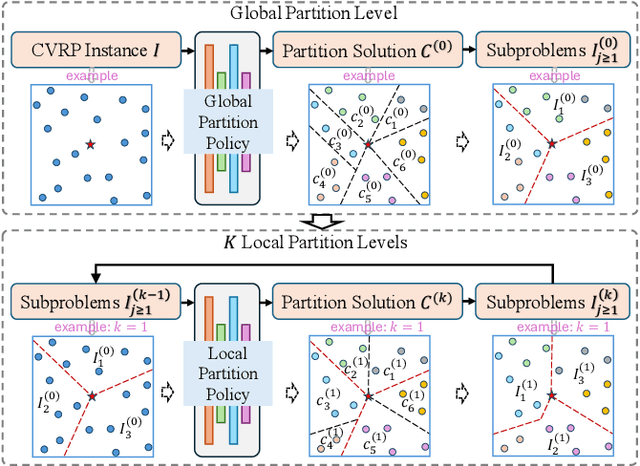
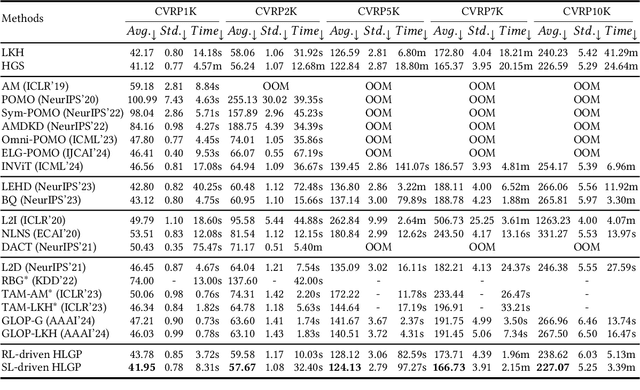
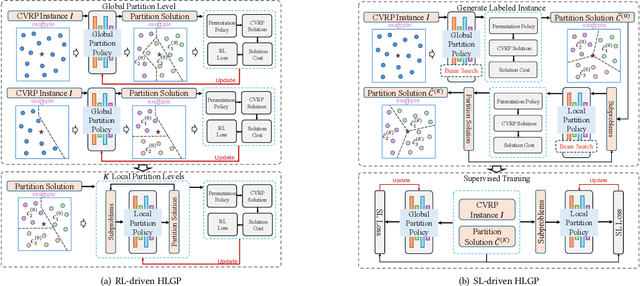
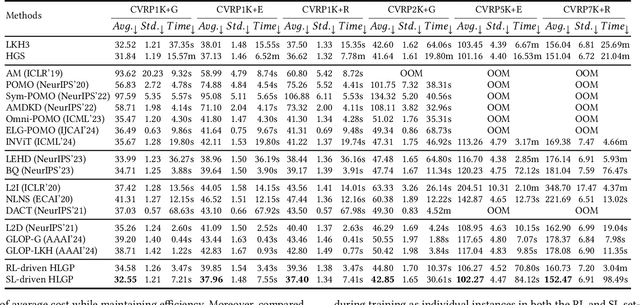
Abstract:Neural solvers based on the divide-and-conquer approach for Vehicle Routing Problems (VRPs) in general, and capacitated VRP (CVRP) in particular, integrates the global partition of an instance with local constructions for each subproblem to enhance generalization. However, during the global partition phase, misclusterings within subgraphs have a tendency to progressively compound throughout the multi-step decoding process of the learning-based partition policy. This suboptimal behavior in the global partition phase, in turn, may lead to a dramatic deterioration in the performance of the overall decomposition-based system, despite using optimal local constructions. To address these challenges, we propose a versatile Hierarchical Learning-based Graph Partition (HLGP) framework, which is tailored to benefit the partition of CVRP instances by synergistically integrating global and local partition policies. Specifically, the global partition policy is tasked with creating the coarse multi-way partition to generate the sequence of simpler two-way partition subtasks. These subtasks mark the initiation of the subsequent K local partition levels. At each local partition level, subtasks exclusive for this level are assigned to the local partition policy which benefits from the insensitive local topological features to incrementally alleviate the compounded errors. This framework is versatile in the sense that it optimizes the involved partition policies towards a unified objective harmoniously compatible with both reinforcement learning (RL) and supervised learning (SL). (*Due to the notification of arXiv "The Abstract field cannot be longer than 1,920 characters", the appeared Abstract is shortened. For the full Abstract, please download the Article.)
The Combined Problem of Online Task Assignment and Lifelong Path Finding in Logistics Warehouses: A Case Study
Feb 11, 2025



Abstract:We study the combined problem of online task assignment and lifelong path finding, which is crucial for the logistics industries. However, most literature either (1) focuses on lifelong path finding assuming a given task assigner, or (2) studies the offline version of this problem where tasks are known in advance. We argue that, to maximize the system throughput, the online version that integrates these two components should be tackled directly. To this end, we introduce a formal framework of the combined problem and its solution concept. Then, we design a rule-based lifelong planner under a practical robot model that works well even in environments with severe local congestion. Upon that, we automate the search for the task assigner with respect to the underlying path planner. Simulation experiments conducted in warehouse scenarios at \textit{Meituan}, one of the largest shopping platforms in China, demonstrate that (a)~\textit{in terms of time efficiency}, our system requires only 83.77\% of the execution time needed for the currently deployed system at Meituan, outperforming other SOTA algorithms by 8.09\%; (b)~\textit{in terms of economic efficiency}, ours can achieve the same throughput with only 60\% of the agents currently in use.
Adjustable Robust Reinforcement Learning for Online 3D Bin Packing
Oct 06, 2023Abstract:Designing effective policies for the online 3D bin packing problem (3D-BPP) has been a long-standing challenge, primarily due to the unpredictable nature of incoming box sequences and stringent physical constraints. While current deep reinforcement learning (DRL) methods for online 3D-BPP have shown promising results in optimizing average performance over an underlying box sequence distribution, they often fail in real-world settings where some worst-case scenarios can materialize. Standard robust DRL algorithms tend to overly prioritize optimizing the worst-case performance at the expense of performance under normal problem instance distribution. To address these issues, we first introduce a permutation-based attacker to investigate the practical robustness of both DRL-based and heuristic methods proposed for solving online 3D-BPP. Then, we propose an adjustable robust reinforcement learning (AR2L) framework that allows efficient adjustment of robustness weights to achieve the desired balance of the policy's performance in average and worst-case environments. Specifically, we formulate the objective function as a weighted sum of expected and worst-case returns, and derive the lower performance bound by relating to the return under a mixture dynamics. To realize this lower bound, we adopt an iterative procedure that searches for the associated mixture dynamics and improves the corresponding policy. We integrate this procedure into two popular robust adversarial algorithms to develop the exact and approximate AR2L algorithms. Experiments demonstrate that AR2L is versatile in the sense that it improves policy robustness while maintaining an acceptable level of performance for the nominal case.
On Computing Universal Plans for Partially Observable Multi-Agent Path Finding
May 25, 2023Abstract:Multi-agent routing problems have drawn significant attention nowadays due to their broad industrial applications in, e.g., warehouse robots, logistics automation, and traffic control. Conventionally, they are modelled as classical planning problems. In this paper, we argue that it is beneficial to formulate them as universal planning problems. We therefore propose universal plans, also known as policies, as the solution concepts, and implement a system called ASP-MAUPF (Answer Set Programming for Multi-Agent Universal Plan Finding) for computing them. Given an arbitrary two-dimensional map and a profile of goals for the agents, the system finds a feasible universal plan for each agent that ensures no collision with others. We use the system to conduct some experiments, and make some observations on the types of goal profiles and environments that will have feasible policies, and how they may depend on agents' sensors. We also demonstrate how users can customize action preferences to compute more efficient policies, even (near-)optimal ones.
 Add to Chrome
Add to Chrome Add to Firefox
Add to Firefox Add to Edge
Add to Edge